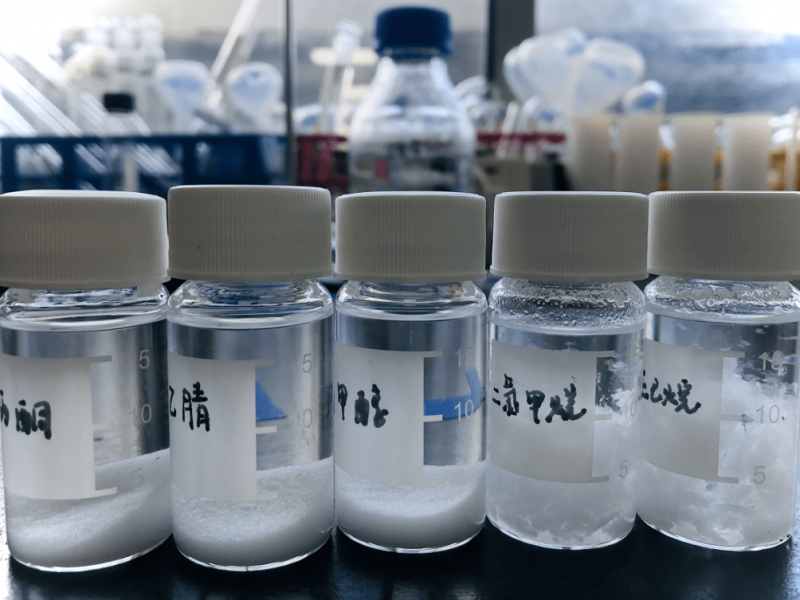
Principles of using desiccant
• The properties of the desiccants are different, and the characteristics of the desiccant and the properties of the desiccant must be fully considered when using it in order to effectively achieve the purpose of drying.
• First make sure that the material being dried does not react with the desiccant.
• Drying speed, drying effect and water absorption of desiccant
• It is best to use acidic desiccants for drying of acidic substances, alkaline desiccants for drying of alkaline substances, and neutral desiccants for drying of neutral substances
• If there is a large amount of water in the solvent, avoid using desiccants that can catch fire (such as sodium metal, etc.) or heat violently when contacting water. You can use a mild desiccant such as calcium chloride for drying and dehydration to reduce the water content. Drying with sodium metal
• The amount of desiccant should be slightly excessive
Metal, metal hydride
• Al, Ca, Mg: commonly used for drying alcohol solvents;
• Na, K: suitable for drying solvents such as hydrocarbons, ethers, cyclohexylamine, and liquid ammonia. Note that there is an explosion hazard when used in halogenated hydrocarbons and must not be used. It also cannot be used to dry methanol, esters, acids, ketones, aldehydes and certain amines. The alcohol contains a small amount of water and can be directly distilled by adding a small amount of sodium metal;
• CaH2: One gram of calcium hydride quantitatively reacts with 0.85 grams of water, so it has a better drying effect than alkali metals and phosphorus pentoxide. It is suitable for drying hydrocarbons, halogenated hydrocarbons, alcohols, amines, ethers, etc., especially cyclic ethers such as tetrahydrofuran, dimethyl sulfoxide, hexamethylphosphoramide and other solvents. Polar aprotic solvents commonly used in organic reactions are also dried by this method;
• LiAlH4: commonly used for drying of solvents such as ethers.
Neutral desiccant
• CaSO4, NaSO4, MgSO4: suitable for drying solvents such as hydrocarbons, halogenated hydrocarbons, ethers, esters, nitromethane, amides, nitriles, etc.;
• CuSO4: Anhydrous copper sulfate is white and turns blue when it contains 5 molecules of crystal water. It is commonly used to detect trace water in solvents. CuSO4 is suitable for the dehydration of alcohols, ethers, esters and lower fatty acids. Methanol and CuSO4 can form adducts, so it is not suitable for use;
• CaC2: suitable for alcohol drying. Note that when using poor-purity calcium carbide, odorous gases such as hydrogen sulfide and phosphine will occur;
• CaCl2: suitable for dry hydrocarbons, halogenated hydrocarbons, ether nitro compounds, cyclohexylamine, nitriles, carbon disulfide, etc. CaCl2 can form adducts with primary alcohols, glycerol, phenols, certain types of amines, esters, etc., so it is not applicable;
• Activated alumina: suitable for drying hydrocarbons, amines, esters, and formamides;
• Molecular sieve: Molecular sieve has a significant moisture absorption capacity when the partial pressure of water vapor is low and the monosodium glutamate is high. Compared with other desiccants, the moisture absorption capacity of molecular sieve is very large. Among various desiccants, molecular sieve has the moisture absorption capacity second only to phosphorus pentoxide. Since almost all solvents can be dehydrated by molecular sieves, they are widely used in laboratories and industry.
Alkaline desiccant
• KOH, NaOH: suitable for alkaline substances such as dry amines and cyclic ethers such as tetrahydrofuran. Acids, phenols, aldehydes, ketones, alcohols, esters, amides, etc. are not applicable
• K2CO3: Suitable for drying solvents such as alkaline substances, halogenated hydrocarbons, alcohols, ketones, esters, nitriles, cellosolves, etc. Not suitable for acidic substances;
• BaO, CaO: suitable for drying alcohols, alkaline substances, nitriles and amides. Not suitable for ketones, acidic substances and esters.
Acid desiccant
• H2SO4: suitable for drying saturated hydrocarbons, halogenated hydrocarbons, nitric acid, bromine, etc. Alcohols, phenols, ketones, unsaturated hydrocarbons, etc. are not applicable;
• P2O5: Suitable for drying hydrocarbons, halogenated hydrocarbons, esters, acetic acid, nitriles, carbon disulfide, and liquid sulfur dioxide. Ethers, ketones, alcohols, amines, etc. are not applicable.
Medium strength desiccant for organic solvents
• CaSO4 1/2H2O very fast
Sold under the trade name Drieritt, with or without a color indicator; very effective, when dry, the indicator (CoCl2) is blue, and becomes pink after absorbing water (capacity CoCl2.6H2O); the applicable temperature range is -50~ +86 degrees. Certain organic solvents can cause CoCl2 to leach out or change the color (such as acetone, alcohols, pyridine, etc.).
• CaCl2 6H2O very fast
Not very effective; only used for hydrocarbons or halogenated hydrocarbons (forms solvates, complexes, or reacts with nitrogen-containing and nitrogen-containing compounds).
• MgSO4 7H2O very fast
Excellent general-purpose desiccant; very inert but may be weakly acidic (avoid use in compounds that are extremely acid sensitive), and may be soluble in some organic solvents.
• 4A molecular sieve high fast
The effect is very effective; it is recommended to use ordinary desiccant first and then use this material, 3A molecular sieve is also an excellent desiccant.
• NaSO4 10H2O slow
Very mild, very effective, cheap, high-capacity; very suitable for preliminary drying, but do not heat the solvent…
• K2CO3 2H2O fast
It is a good desiccant for ester nitrile ketones, especially alcohols, and cannot be used for acidic compounds.
• NaOH, KOH is extremely high and fast
Very effective but only suitable for inert solutions that will not dissolve them; especially suitable for amines.
• H2SO4 extremely high, extremely fast
The effect is very effective, but it is only used to dry saturated hydrocarbons or aromatic hydrocarbons or halogenated hydrocarbons (sulfuric acid will react with olefins or other basic compounds to make them lose quality).
• Alumina or silica gel (SiO2) extremely high, extremely fast
The function is especially suitable for hydrocarbons and should be finely ground; after use, heating (SiO2 is 300 degrees, Al2O3 is 500 degrees) can be reactivated.
